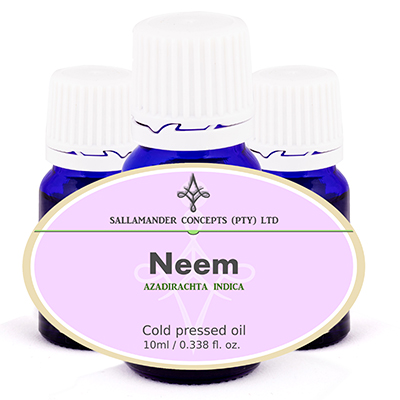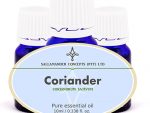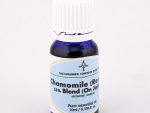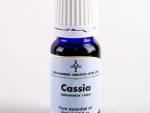Information on Neem Essential oil (Azadirachta indica)
Organic cold-pressed Neem essential oil is expressed from the seed of the Azadirachta indica tree.
The tree is part of the mahogany family – Meliaceae and it is one of two species in the genus Azadirachta, native to India, Sri Lanka, Malaysia, Bangladesh and Pakistan.
It is a very strange smelling oil – some people think it smells of garlic, other think it has an onion smell, while others cannot really define the smell – but take note – it does have a strange smell.
When using it for its therapeutic properties, the smell can be masked by adding other more fragrant smelling essential oils.
Origin
The Neem tree is a fast growing, long-life tree, popular in the tropics and is grown for its ornamental value, as well as for its therapeutic value and is used as fuel for its workable, but unpleasant smelling wood.
The Latin name of the tree is derived from the Persian word azaddhirakt – meaning “noble tree”.
In Ayurvedic medicine Neem is the most important detoxicant and is a very potent febrifuge (reducing fever) and is used to treat intermittent fevers and has shown to contain effective anti-malarial (Plasmodium falciparum) compounds.
The seed (from which we cold press our oil) yields Margosa oil (other word for Neem oil) and is a non-drying oil with insecticidal and antiseptic properties.
Almost all of the tree can be used.
In herbal application the leaves, flowers, bark, seeds and oil is used.
It is a bitter tonic herb that is used for clearing toxins, reducing inflammation, lowering fever, promoting healing and in general promoting and improving body functions.
It destroys a wide range of parasitic organisms and is also an insecticidal compound.
Studies have shown it to be a spermicidal (killing sperm).
In Indian tradition Neem is one of the most important herbal ingredients – not only to help fight certain health problems, but also used in the earliest cosmetics and skin care products.
Neem is used to to protect stored grains and pulses throughout the year as it is a great deterrent for pests.
Although Indian women incorporated Neem essential oil into their daily beauty and hygiene regimen, men used the oil to prevent baldness and graying of the hair, and decoctions of Neem oil were used to remove lice and to combat dandruff.
Skin allergies were sorted out by mixing a teaspoon of dried leaf Neem powder with a teaspoon of ghee (clarified butter) , which was placed on irritated skin.
The fine twigs of the tree were chewed until the fibers were open, and then used as a toothbrush.
The European Patent Office (EPO) in 1995 granted a patent on an anti-fungal product, derived from Neem, to the US Department of Agriculture and the multinational company – W. R. Grace and Company. This patent grant was challenged by the Indian government, because the process for which the patent had been granted had actually been in use in India for over 2000 years.
In 2000 the European Patent Office made a ruling in India’s favor. However, the US company filed an appeal, claiming that prior art about the product had never been published in a scientific journal.
At last, on 8 March 2005 the appeal was lost and the European Patent Office revoked the patent rights – keeping the Neem tree free of patent restrictions.
Oil Properties
Neem essential oil is generally light to dark brown depending on the time of harvest as well as growing conditions before harvesting.
It is bitter and has a strong odor – described by some as a combination of the smell of peanut and garlic.
The oil normally solidifies at room temperature, and to get it in liquid form, place the container in hot water (not boiling) and wait for the oil to liquefy.
Origin
The tree is native to South Asia, and is grown on a large scale in India although the tree has been successfully grown in Laos, Burma, Thailand, Africa, Fiji, Mauritius, Malaysia, Indonesia, Cambodia, as well as Latin America.
The Neem tree can reach a height of 12-15 m (40 – 50 feet) and is evergreen, but in severe drought it may shed most or nearly all of its leaves. The branches are wide spread and the diameter of the tree is about 12 m (40 feet).
Extraction of Neem essential oil
The method of extracting oil influences the quality and composition of the oil obtained.
The best way to expel the oil is by cold-pressing the seeds – which is how our oil is extracted.
The oil can also be obtained by solvent extraction although this normally yields a lower quality oil and is mostly used for soap manufacturing.
Chemical Composition of Neem essential oil
The oil comprises mainly of triglycerides and large amounts of triterpenoid compounds. It furthermore contains steroids (campesterol, beta-sitosterol, stigmasterol) and triterpenoids, of which Azadirachtin is the most well known and studied.
The Azadirachtin content of Neem oil can vary a lot – from 300ppm to over 2,500ppm depending on the extraction and quality of the Neem seeds used to produce the oil.
Precautions
Neem essential oil oil should NOT be given internally to the weak, very young (any child under 3 years of age) or the very old and must be avoided by any pregnant women, or women trying to become pregnant. High continuous intake could cause liver problems.
Neem seed essential oil oil can, when taken internally, produce a toxic effect in humans, and side effects include diarrhoea, nausea, vomiting, acidosis, encephalopathy, etc.
The toxic effects might be due to the presence of aflatoxin and other toxic compounds present in Neem oil.
Neem essential oil shows toxicity to fish like tilapia and carp, and oral administration of the oil in rats and rabbits (at 14 ml/kg and 24ml/kg respectively) produced a severe hypoglycaemic effect and possibly targets the central nervous system and lungs.
Taking Neem essential oil internally is not recommended and taking internal doses as small as 5 ml has killed infants – and although there are some people that state that the toxicity was caused by other contaminants, and not the oil itself – we would recommend to err on the side of safety.
A toxicological test in Germany, using clean Neem kernels resulted in no toxicity, even at a concentration of 5,000 mg per kg of body weight in rats.
Neem capsules containing the aqueous extract are sold – but this is an extract from the leaves, and does not contain the oil from the seeds. However, before taking ANY type of supplement – please discuss it with your medical practitioner beforehand.
Therapeutic properties
The internal medicinal uses of Neem essential oil include malaria, tuberculosis, rheumatism, arthritis, jaundice and intestinal worms as well as skin diseases.
It also has alternative (increases vitality) properties.
The oil is NOT normally taken internally – but as a decoction made from the leaves.
The extract of Neem leaves has also demonstrated significant anti-diabetic potential.
Neem also enhances the immune system – making it a possible substance of use for AIDS and cancer patients, although more research on the efficacy and treatment protocol needs to be done.
It also helps to decrease blood sugar levels and may possibly be used to reduce the use of insulin by 30%-50% – making it a possible effective compound for diabetic patients.
The extracts are also beneficial for heart diseases, hepatitis, fungal infection, malaria, psoriasis, and ulcers.
Unlike the oil, the leaves have a pleasant odor and the extract made from them is either an alcoholic tincture or a tea.
Neem essential oil is used externally for ringworm, eczema, psoriasis, lice, fungal infection, as well as for painful joints and muscles.
The cosmetic use of Neem oil includes the fighting of acne and pimples, as well as improving skin elasticity.
Tips on how to use and dilute Neem essential oil
We have listed some recipes / ways to use Neem oil below – but a rule of thumb to remember is to keep your dilution of Neem oil to about 1% – 4% of any mixture that you apply directly onto your skin.
Always start using at a low dilution rate and increase over time.
Some of the recipes below use higher percentages – but keep a lookout for any skin irritation.
Cuts, wounds, minor skin disorders and mosquito and insect repellant
Mix with Vaseline or a carrier oil in a ratio of 1 part neem oil:5 parts fatty oil / Vaseline and apply to affected area.
Athlete’s foot
Add 15 ml to warm water and soak the feet in this preparation.
Head lice
Mix 50/50 with a carrier oil and massage into the hair and scalp. Leave on for 1 hour and shampoo. Repeat once weekly for 3 weeks or as long as the problem persists. Do not use this mixture on children under the age of 5 years. Watch for irritation to the skin and wash off and rinse well should this occur.
Stop mosquitoes breeding
Spray or pour oil on all breeding areas. The oil can be emulsified (to mix with water) by adding normal dish washing liquid to it.
Plant protection
Add 30 ml to 1 liter of water and add 1 ml of dishwashing liquid. Mix well and spray immediately for plant protection. Do not store the mixture; make fresh formulation for each spray. Spray the mixture on top of all the leaves and on the undersides where insects often hide – you can also spray it around the roots.
Lamp oil to ward off mosquitoes
Add 5 – 10% oil to any lamp oil and burn lamp normally.
Dandruff and itchy scalp
Add a few drops to your regular shampoo.
Ticks and fleas on animals
Add a few drops to your normal pet shampoo (ratio should be 30 ml (1 oz.) to 240 ml (8 oz.) shampoo for large dogs). Personally we have found that plain baby shampoo works the best. Rinse well after applying.
Use lower dilutions on younger and smaller pets (from 2ml neem oil to 240ml shampoo).
Do not use on cats, very young puppies, birds and other small animals. Discourage licking during use. Do not use on sick animals.
Start at a very low dilution and gradually increase the dose.
Warts
Apply 1 drop of undiluted oil directly on warts once per day. Watch carefully for any possible irritation, and should that occur discontinue use. Continue for 2-3 weeks.
Psoriasis, cold sores, eczema, athletes foot, skin ulcers and other fungal skin conditions
Mix 1 tablespoon (15 ml) with 4 ounces (120 ml) carrier oil such as jojoba or grape seed oil and apply twice a day to affected skin. Should skin irritation occur, discontinue use, or make mixture with less Neem oil.
Pet and livestock spray for ticks, fleas, mange mites and other pests
Mix 1 ounce (30 ml) oil with 1 gallon (3.8 liter) water and add a few drops of dishwashing liquid (to emulsify the oil). Place mixture into a spray bottle or other type of sprayer, and spray animals once every two weeks. (This mixture can also be used on indoor and outdoor plants as well as flowers and vegetables.)
Cleaning the house
Add to carpet shampoos and spray mattresses to kill dust mites.
Hand wash
Add a couple of drops to liquid hand soap for antibacterial properties.
FOR ALL THE ABOVE
As Neem essential oil has a rather strong smell you might want to add a few drops of essential oil to any mixture to mask the smell. Lavender or lemongrass essential oils work well – but you could add your personal favorite.
Store Neem essential oil in a cool dark place, away from sunlight.
Neem essential oil can easily solidify. Should this happen put the bottle in warm water (below 95 degree F / 35 degrees C) to liquefy. Do not place in near boiling water, as it may reduce the effectiveness of the oil.
As with all essential oils: Start using at a low dilution rate and slowly build up, watch for any skin irritation. Stop using if irritation occurs and wash the area with a mild and gently soap. Rinse well.






